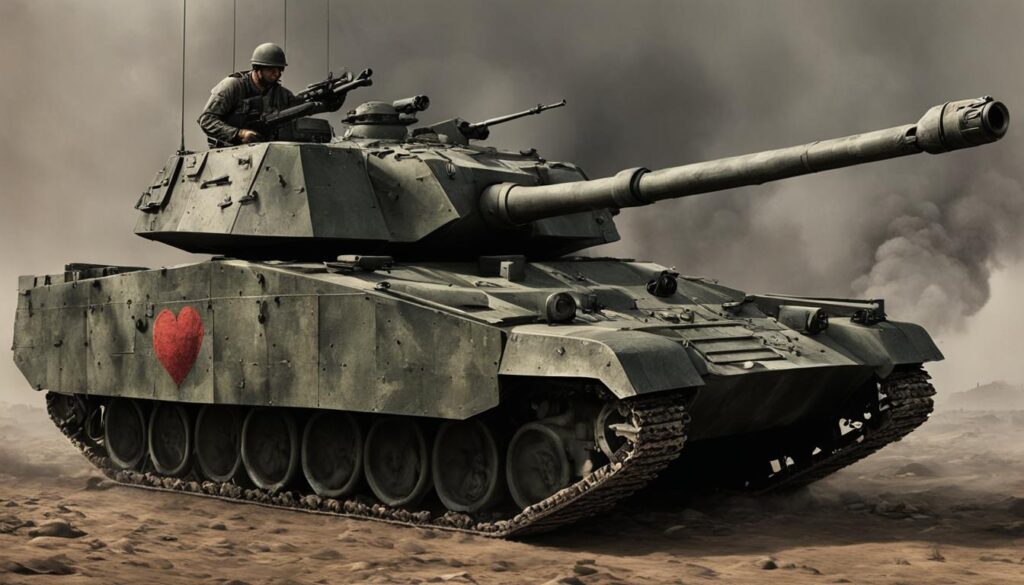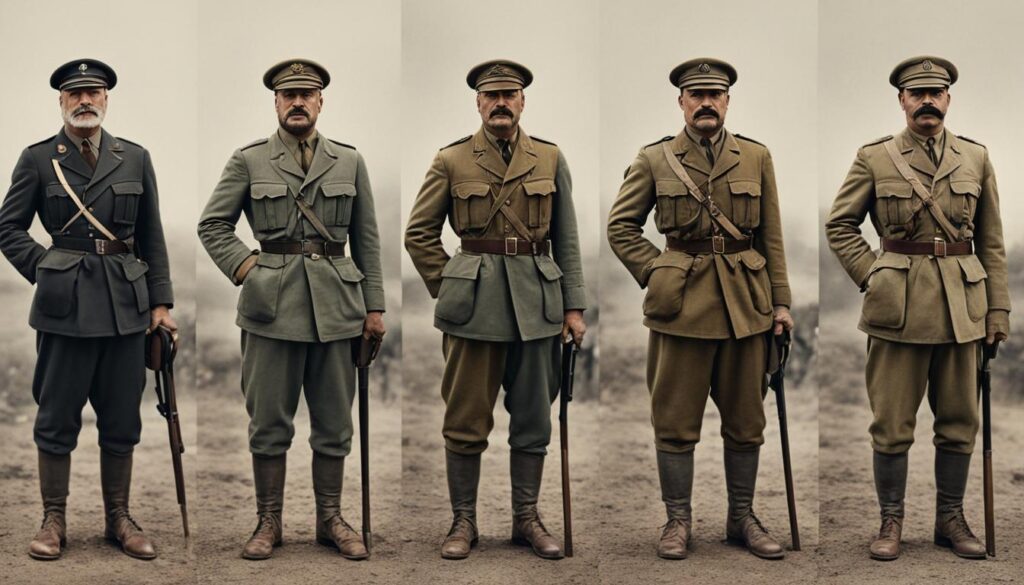Welcome to our audiobook review of Ernest Hemingway’s classic novel, “A Farewell to Arms.” In this comprehensive review, we will explore the narration, writing style, characters, and themes of the novel, as presented in its audiobook format. Ernest Hemingway’s works have left an indelible mark on the world of literature, and “A Farewell to Arms” is no exception, serving as a testament to the author’s craft and vision.
Throughout this review, we will closely examine the audiobook version of the novel, offering insights and analysis on its historical context, plot summary, writing style, and more. Whether you are a long-time fan of Hemingway’s work or a newcomer to his literary universe, this audiobook review is sure to offer valuable insights and perspectives on this beloved novel.
So, without further ado, let us dive into our audiobook review of “A Farewell to Arms” by Ernest Hemingway.
The Historical Context of “A Farewell to Arms”
The publication of Ernest Hemingway’s “A Farewell to Arms” in 1929 came at a time of significant political, social, and cultural change. Set amidst the backdrop of World War I, the novel explores themes related to war, love, and mortality, while also reflecting upon the larger cultural zeitgeist of the interwar period.
One key aspect of the historical context surrounding the novel is the impact of the first World War on Hemingway himself. As a volunteer ambulance driver, he witnessed firsthand the horrors of the war and suffered multiple injuries, including a severe leg wound. These experiences would come to shape his writing and his views on war, leading him to adopt a stoic, understated writing style and a pessimistic perspective on human nature.
Another important element of the historical context is the rise of modernism in literature. “A Farewell to Arms” is often considered a prime example of modernist literature, characterized by its experimental narrative structures, psychological complexities, and fragmented portrayal of reality. In this sense, the novel can be seen as a reflection of larger cultural movements of the time, such as the influence of Freudian psychology, the rejection of traditional values, and the embrace of new forms of artistic expression.
Finally, it is worth noting the broader political and economic changes that were taking place in 1920s Europe. The aftermath of World War I brought about significant political upheaval, including the collapse of empires and the rise of totalitarian regimes. At the same time, the world was experiencing a period of economic growth and technological innovation, leading to significant changes in lifestyle and expectations.
| Historical Context | A Farewell to Arms |
|---|---|
| World War I | The novel explores the impact of the war on individuals and society. |
| Modernism | The novel adopts an experimental narrative style and reflects broader cultural movements of the time. |
| Political and Economic Changes | The novel portrays the impact of political upheaval and technological innovation on everyday life. |
Notable Quotes:
“The world breaks everyone and afterward many are strong at the broken places.” – Ernest Hemingway
“The things that went so well between us were not spoken, and we had no other language.” – Ernest Hemingway
Plot Summary of “A Farewell to Arms”
The plot of “A Farewell to Arms” centers around the love story between Frederic Henry, an American ambulance driver serving in Italy during World War I, and Catherine Barkley, an English nurse at a nearby hospital. The two fall in love and begin a passionate affair despite the war and their different backgrounds.
As the war drags on, Frederic becomes disillusioned with the conflict and decides to desert the army with Catherine. The couple flees to Switzerland, where they hope to start a new life together. However, their happiness is short-lived as Catherine goes into labor and dies during childbirth, leaving Frederic to grieve alone.
The novel explores themes of love, war, disillusionment, and the fragility of life, as well as the complexities of human relationships.
The Major Events in the Plot
| Event | Description |
|---|---|
| Frederic Meets Catherine | Frederic meets Catherine Barkley at a hospital in Italy where she is a nurse and he is an ambulance driver. The two fall in love despite their different backgrounds and the ongoing war. |
| Their Relationship Deepens | Frederic and Catherine’s relationship deepens as they spend more time together and share their deepest thoughts and feelings. Frederic decides to desert the army and flee with Catherine to Switzerland. |
| Tragedy Strikes | Catherine goes into labor and complications arise during childbirth. The doctors are unable to save her, leaving Frederic to cope with both the loss of Catherine and the death of their newborn child. |
| Frederic’s Grief | Frederic returns to his unit, but struggles to come to terms with Catherine’s death and the war. The novel ends with him struggling to find meaning in a world that has been shattered by loss. |
“‘What do you want to do?’
‘I want to put my arms around you and kiss you.'” – Frederic and Catherine
The plot of “A Farewell to Arms” is both a poignant love story and a powerful anti-war statement. Hemingway’s spare, understated prose and vivid descriptions of war and its aftermath create a lasting impression on readers.
The Writing Style of Ernest Hemingway
Ernest Hemingway’s writing style is often described as concise, stripped-down, and direct, characterized by short sentences, sparse descriptions, and a focus on action and dialogue over exposition. This style, sometimes referred to as minimalism, is evident throughout “A Farewell to Arms,” contributing to the emotional impact of the story and its underlying themes.
Hemingway’s writing is also notable for his use of repetition, both in terms of phrases and images, as well as his attention to detail. He often includes specific sensory details, such as the smell of a particular fragrance or the taste of a drink, which serve to ground the narrative and give it a vivid, immersive quality.
Furthermore, Hemingway’s writing style is deeply influenced by his experiences as a journalist, which can be seen in his commitment to objective reporting and his emphasis on accuracy and realism. This journalistic approach is particularly effective in the war scenes depicted in “A Farewell to Arms,” which feel authentic and visceral.
“The world breaks everyone, and afterward, some are strong at the broken places.”
This famous quote from “A Farewell to Arms” exemplifies Hemingway’s spare yet powerful use of language, emphasizing the resilience of the human spirit in the face of adversity. Overall, Hemingway’s writing style in “A Farewell to Arms” is a masterful example of how less can sometimes be more in terms of creating impactful, memorable literature.
Themes Explored in “A Farewell to Arms”
As one of Ernest Hemingway’s enduring works, “A Farewell to Arms” explores a range of complex and poignant themes that have resonated with readers for decades.
One of the central themes of the novel is the nature of war and its devastating impact on individuals and societies. Through vivid, visceral descriptions of battle and its aftermath, Hemingway reveals the trauma and horror of war, while also exploring themes of loyalty, sacrifice, and duty.
The novel also delves into the complexities of love in wartime, as the central characters Frederic Henry and Catherine Barkley navigate their feelings for each other against the backdrop of a turbulent and dangerous world. Hemingway’s exploration of love is intimate, raw, and ultimately tragic, serving as a poignant commentary on the fleeting nature of human connection.
Another key theme of the novel is loss and the powerful emotions it can evoke. Hemingway examines how individuals grapple with grief, both for loved ones and for the loss of their own identities and sense of self.
Finally, “A Farewell to Arms” is concerned with the individual’s struggle against external forces, such as war, societal expectations, and personal beliefs. Hemingway’s focus on individual agency and choice speaks to universal human experiences, making the novel a timeless meditation on the human condition.

Analysis of the Characters in “A Farewell to Arms”
In “A Farewell to Arms,” Hemingway presents a rich cast of characters struggling to navigate the complex realities of love and war. The protagonist, Frederic Henry, is an American ambulance driver serving in the Italian army during World War I. Alongside him is Catherine Barkley, an English nurse he falls deeply in love with.
Throughout the novel, Hemingway develops these characters with nuance and depth, exploring their motivations and inner conflicts. Frederic is initially characterized by his detachment and apathy towards the war, but as he falls in love with Catherine, he begins to question his earlier fatalism and ultimately risks everything to be with her. Meanwhile, Catherine’s own traumatic experiences have left her vulnerable and hesitant to fully give herself to love, despite her feelings for Frederic.
Other notable characters include Rinaldi, Frederic’s friend and fellow ambulance driver, who is characterized by his hedonistic nature and unbridled enthusiasm for women, and the Priest, who serves as a moral compass and confidant to Frederic.
Through his careful characterizations, Hemingway is able to convey the complex emotional and psychological toll of war, as well as the transformative power of romantic love.
Character Analysis
| Character | Role | Motivations | Conflicts | Development |
|---|---|---|---|---|
| Frederic Henry | Protagonist, American ambulance driver | Initially detached from war, falls in love with Catherine | Internal struggle between love and duty, escape from the war | Transforms from apathetic to devoted, ultimately risking everything for love |
| Catherine Barkley | English nurse, love interest of Frederic | Resistant to love due to trauma, falls in love with Frederic | Protecting her heart from further pain, navigating cultural differences with Frederic | Opens herself up to love, ultimately tragically sacrificing everything for it |
| Rinaldi | Friend of Frederic, ambulance driver | Hedonistic, enjoys women and parties | Jealousy and betrayal towards Frederic and Catherine | Retains his carefree attitude, but ultimately loses his friend and love interest |
| The Priest | Moral compass and confidant to Frederic | Committed to faith and duty, supportive of Frederic’s love for Catherine | Navigating his own personal crises of faith and purpose, offering guidance to Frederic | A steady presence throughout the novel, ultimately delivering the novel’s poignant final lines |
Overall, the characters of “A Farewell to Arms” are deeply human, their complexities representing the multifaceted realities of life during wartime. By examining their motivations, conflicts, and development, we gain a deeper understanding of the novel’s themes and the ways in which Hemingway masterfully portrays the impact of war on the human psyche.
Setting and Atmosphere in “A Farewell to Arms”
The setting of “A Farewell to Arms” is an essential aspect of the story’s emotional impact. The novel is primarily set in Italy during World War I, with frequent references to other locations, such as the Swiss Alps and the battlefields of Europe. The descriptions of the Italian countryside, its people, and culture reflect Hemingway’s deep connection to the region.
The author’s detailed descriptions of the landscape and weather create an immersive atmosphere that transports the reader to another time and place. The setting also serves as a metaphor for the larger themes of the book, such as the contrast between idyllic beauty and the brutality of war.
Table 7.1: Elements of Setting in “A Farewell to Arms”
| Setting Element | Description |
|---|---|
| Geographical Location | The novel is set mainly in Italy, with vivid descriptions of the country’s landscape and culture |
| Period and Historical Context | The story takes place during World War I, with references to the social and political climate of the time |
| Climate and Weather | The weather patterns in the novel often mirror the characters’ emotional states, contributing to the overall mood and atmosphere |
| Architecture and Infrastructure | The settings vary from rural villages to military bases and hospitals, showcasing the impact of war on the built environment |
“The hills across the valley of the Ebro were long and white. On this side there was no shade and no trees and the station was between two lines of rails in the sun. Close against the side of the station there was the warm shadow of the building and a curtain, made of strings of bamboo beads, hung across the open door into the bar, to keep out flies. The American and the girl with him sat at a table in the shade, outside the building. It was very hot and the express from Barcelona would come in forty minutes. It stopped at this junction for two minutes and went on to Madrid.” – “A Farewell to Arms” by Ernest Hemingway
As seen in this quote, Hemingway’s atmospheric descriptions set the scene for the story’s opening scene, highlighting the harshness of war and the fragility of life. The intense heat, lack of shade, and presence of flies all contribute to the uncomfortable atmosphere.
Overall, the setting and atmosphere of “A Farewell to Arms” play a vital role in shaping the reader’s emotional experience of the book and contribute to its timeless literary status.
Audiobook Narration and Performance
With the rise of digital downloads and streaming services, audiobooks have surged in popularity, providing listeners with an alternative way to experience literature. In the case of “A Farewell to Arms,” the audiobook version delivers a unique listening experience that brings Hemingway’s exquisite prose to life in a new way.
The audiobook narration, performed by actor John Slattery, captures the poignancy and urgency of Hemingway’s writing, immersing listeners in the story’s emotional landscape. Slattery’s dynamic range and subtle nuances enhance the performance, making each character distinct and memorable.
Slattery’s performance delivers a fully realized interpretation of Hemingway’s story, earning the audiobook high praise from critics and fans alike.
In addition to Slattery’s skilled narration, the audiobook version of “A Farewell to Arms” features high-quality sound design that enhances the atmosphere and adds dimension to the listening experience. From the clatter of military equipment to the soft whispers of intimate moments, the sound effects provide a visceral connection to the story’s setting and emotions.
If you’re considering experiencing “A Farewell to Arms” in audiobook format, rest assured that the narration and performance are top-notch, providing a captivating immersion into Hemingway’s timeless masterpiece.
Comparisons with Other Hemingway Works
Ernest Hemingway is widely regarded as one of the most significant authors of the 20th century, known for his concise, direct prose and piercing insights into the human condition. As such, it’s worth exploring how “A Farewell to Arms” compares to some of his other iconic works.
“The Old Man and the Sea”
First published in 1952, “The Old Man and the Sea” is a novella that tells the story of an aging Cuban fisherman named Santiago and his epic struggle to catch a giant marlin in the Gulf Stream. Like “A Farewell to Arms,” the novella explores themes of determination, perseverance, and the struggle against external forces. However, whereas “A Farewell to Arms” is set against the backdrop of World War I, “The Old Man and the Sea” takes place in the more idyllic surroundings of the Caribbean Sea.
“For Whom the Bell Tolls”
Published in 1940, “For Whom the Bell Tolls” is a novel set against the backdrop of the Spanish Civil War and follows a group of anti-fascist guerrillas as they plan and execute a mission to destroy a strategically important bridge. Like “A Farewell to Arms,” the novel explores themes of love and war, as well as the individual’s role in the face of wider political events. However, “For Whom the Bell Tolls” is a more overtly political work than “A Farewell to Arms,” exploring the ethics of violence and rebellion in a way that Hemingway had not previously attempted.
“The Sun Also Rises”
Perhaps Hemingway’s most famous work, “The Sun Also Rises” was first published in 1926 and tells the story of a group of American and British expatriates as they travel from Paris to Pamplona for the running of the bulls. Similar to “A Farewell to Arms,” the novel explores themes of disillusionment, alienation, and the search for purpose in life. However, whereas “A Farewell to Arms” is set against the backdrop of war, “The Sun Also Rises” is a more introspective work that focuses on the inner turmoil of its characters.

Critical Reception of “A Farewell to Arms”
Upon its publication in 1929, “A Farewell to Arms” received both praise and criticism from literary critics. While some hailed it as a masterpiece of modern literature, others found fault with its structure and themes.
“‘A Farewell to Arms’ is not a great book, but it is a thoroughly good one, full of vitality and intensity. It is in fact a long, episodic novel of some three hundred thousand utterances which the reader will find almost as easy to read as the racing results in the sports page of the morning newspaper… It is the work of a man who has thoroughly learned the trade of inventing stories, and knows exactly what he wishes to do with his materials. And it is a work which, for such a man, is well worth doing.”
– Edmund Wilson, The New Republic (1929)
Others, however, criticized Hemingway’s portrayal of the war and its effects on individuals.
“This war story, for all its smooth and tense narrative, its high purpose and nobility, its ecstasy of first love, is fakery and hokum. And this conclusion is made reluctantly because Mr. Hemingway is an accomplished and serious craftsman…he repeats sentimentality and even melodrama with a perfectly straight face.”
– Langston Hughes, The New Masses (1929)
Despite the criticism, “A Farewell to Arms” has endured as a classic of twentieth-century American literature, with its exploration of war, love, and loss resonating with readers and scholars alike.
Impact and Legacy of “A Farewell to Arms”
Since its publication in 1929, “A Farewell to Arms” has left a significant impact on the literary world, cementing Ernest Hemingway’s reputation as a leading figure of the modernist movement. The novel’s portrayal of the disillusionment and trauma of war struck a chord with readers and critics alike, earning it high praise and widespread recognition.
Perhaps one of the most significant aspects of “A Farewell to Arms” is its influence on subsequent literature. The novel’s anti-war sentiments and exploration of the human condition in times of conflict paved the way for works such as Kurt Vonnegut’s “Slaughterhouse-Five” and Joseph Heller’s “Catch-22.”
Moreover, Hemingway’s distinct and spare writing style, showcased in “A Farewell to Arms,” inspired numerous authors in the decades that followed. Writers such as Raymond Carver, John Updike, and Cormac McCarthy all took inspiration from Hemingway’s approach, resulting in a literary legacy that endures to this day.
Overall, “A Farewell to Arms” remains a vital piece of literature that continues to captivate and challenge readers. Its impact on the literary world is undeniable, and its legacy lives on through the works of countless authors who have been inspired by Hemingway’s powerful storytelling and unique voice.
Recommendations and Closing Thoughts
For those interested in exploring “A Farewell to Arms” in audiobook format, we highly recommend the recording narrated by actor John Slattery. His delivery brings a nuanced and engaging interpretation to the narration, capturing the emotional depth and poetic language of Hemingway’s prose.
Overall, “A Farewell to Arms” is a timeless classic that continues to captivate readers with its poignant portrayal of love and loss set against the backdrop of war. The audiobook version serves as a fantastic way to experience the story anew, and we encourage both long-time fans and newcomers alike to give it a listen.
Conclusion
Overall, the audiobook version of “A Farewell to Arms” offers an engaging and immersive experience of Hemingway’s classic work. The voice actors’ performances capture the emotional depth and complexity of the characters, and the atmospheric descriptions evoke a vivid sense of time and place.
For those interested in exploring the themes of war, love, and loss in literature, “A Farewell to Arms” is a timeless and thought-provoking choice. Its impact on the literary world and cultural legacy remain relevant today, making it a must-read for any serious reader.
Overall, we highly recommend the audiobook adaptation of “A Farewell to Arms” for its exceptional narration and ability to bring Hemingway’s words to life in a new and powerful way.



